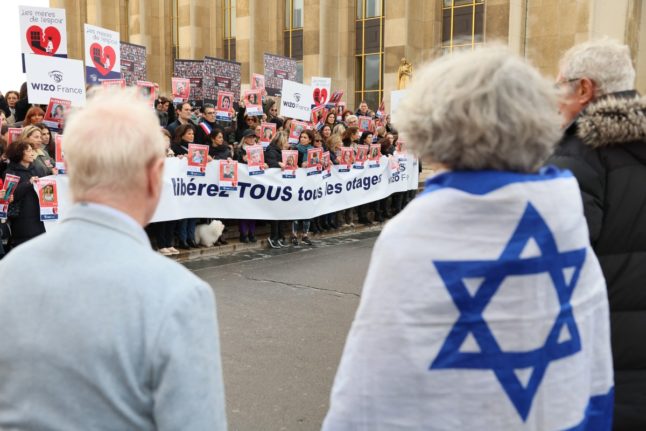In Paris, they waited anxiously for news of family members who have gone missing from the Beeri kibbutz just four miles from the Gaza Strip — a community that their family helped found and one of the worst-hit during the October 7 attack.
A total of 85 of the kibbutz residents were killed in the attack, and 30 others are presumed missing or taken hostage, including several members of the Orloff family.
“What matters most today is the defence of these hostages, innocent people,” said Eric Justman, 70.
“We want the Red Cross to be able to see them and we want proof of life,” added his sister, Ariane Tamir, 75.
Following the deadliest attack in its history, Israel launched an air, artillery and naval bombardment alongside a ground offensive to destroy Hamas, killing nearly 15,000 people, according to the Hamas government in Gaza.
The current events are rekindling the wounds of one family history littered by persecutions.
Justman and Tamir’s grandmother was Chana Orloff — a Jewish woman who would eventually become a celebrated sculptor but who in 1905 fled the pogroms in what was then the Russian Empire, and today is Ukraine, to Palestine.
After several years she moved to Paris in 1910 to study and while there, she began to produce sculptures. She also met and married Ary Justman, a Warsaw-born Jewish poet.
They had a son — the father of Justman and Tamir — but Ary Justman died in the influenza epidemic in 1919.
Orloff blossomed as an artist, creating portraits of many Parisian elite, exhibiting her work in the US and, at the request of Tel Aviv’s first mayor Meir Dizengoff, creating many works to help found the Tel Aviv Museum.
She barely avoided the Vel’d’Hiv roundup — the mass arrests of Jewish families by the French police at the behest of German authorities on July 16 and 17, 1942.
With two friends warning her that she faced arrest, she fled to Switzerland with her son. When she returned after the war, she found her house and studio ransacked and pillaged.
“That Orloff family, with its eight children — one of whom died in Ukraine before going into exile — left that country because of the pogroms,” said Tamir.
“Some of them have now suffered another pogrom of unimaginable violence, with the idea of extermination reminiscent of the Shoah, there’s no doubt about it,” she said.
She was speaking at the Chana Orloff studio-museum in Paris, where bronze sculptures and woodcuts by her grandmother, who died in 1968 while on a visit to Israel, are on display.
Painful family history
As part of the negotiations with Hamas, Israel provided the families concerned with an initial list of people to be released, but none of the Orloff clan were on it, they said in an interview conducted before the first releases this weekend.
A second group of Israeli hostages were released Saturday.
The Beeri kibbutz was founded in 1946 by Chana Orloff’s niece and her husband. When Hamas fighters launched their attack last month, their descendants who still live there, including three children aged three, eight and 12, were gathered for a “day of celebration” in two houses at the kibbutz.
“We are certain that three of them are dead,” said Justman.
“The seven people we have no news of have not been identified and we are not certain that they are hostages,” said Tamir, adding that she had only one witness statement that one of them had been seen “thrown into the boot of a car on the road to Gaza”.
The current events rekindling echoes of painful family history at a time when Orloff is being brought back into the spotlight at two Paris exhibitions at the Zadkine Museum and the Museum of Art and History of Judaism.
“We’re taking action and communicating as much as possible,” said Eric Justman. “It’s like a bottle thrown into the sea that will contribute to their release and their good health. The more we communicate about the hostages, the more valuable they are and the less likely they are to be killed by Hamas.”
‘Dove is in a bad way’
His sister sees this “terrible tragedy”, which she says “struck peace activists opposed to (Israeli Prime Minister Benjamin) Netanyahu and the settlements”, as an “echo of history”.
She points out that “in my cousin Shoshan’s house, which was blown up, burnt down and all the inhabitants taken, there was a bronze statue by Chana Orloff and, from the images we have seen, there is no trace of it, so it too was taken”.
Among the sculptures surrounding Tamir as she spoke was a bronze bear, fighting a dove.
“When I look at this work today, I say to myself that the dove is in a bad way”, she said.
After some 15 years of fighting, earlier this year the family obtained the return of “Didi”, a 1921 wooden sculpture of Orloff’s young son, Elie, Justman and Tamir’s father, which has been entrusted to the Museum of Jewish Art and History.



 Please whitelist us to continue reading.
Please whitelist us to continue reading.
Member comments